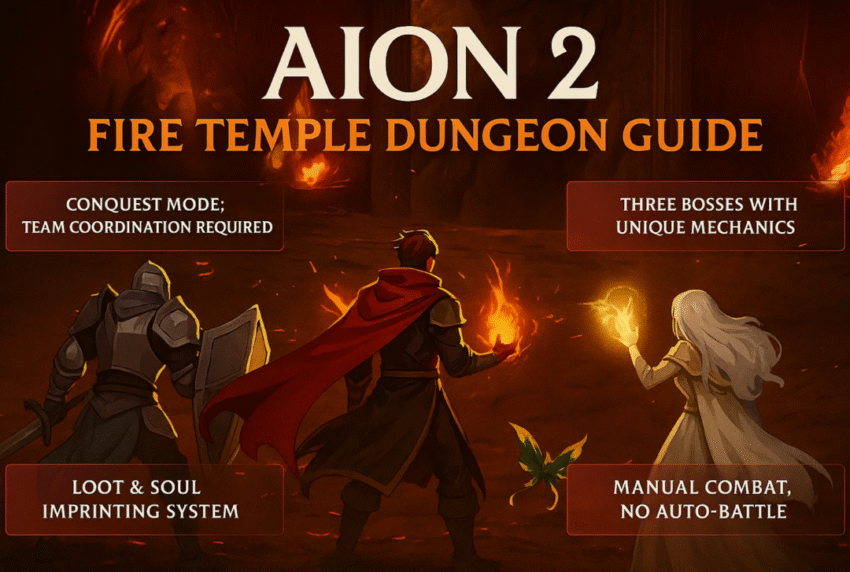The Fire Temple in Aion 2 offers an early but challenging dungeon experience that showcases the game’s commitment to tactical group combat and manual gameplay. In the recent developer play session, we got a closer look at how the dungeon operates, its boss encounters, and the systems that reward teamwork and precision over automation.
Below is a structured analysis of what was revealed, along with insights that will help players prepare for this fiery battleground.
Overview: Dungeon Entry and Difficulty Modes
The dungeon can be accessed through Exploration Mode or Conquest Mode. Exploration is meant for solo learning, while Conquest demands coordination and offers tougher enemies and richer rewards. Players can use Kibellisk teleport points to regroup quickly during party play, making team management smoother even in chaotic fights.
| Mode | Description | Recommended Players | Key Rewards |
|---|---|---|---|
| Exploration | Lower difficulty for solo learning and map familiarization | 1 player | Basic gear, crafting materials |
| Conquest | High difficulty with elite enemies and multi-phase bosses | 3–5 players | Rare gear, tradeable loot, Ode Energy Cubes |
Party Setup and Role Coordination
The development team demonstrated a setup of Guardian (Tank), Mage (DPS), and Healer (Support). Each class has distinct utility and movement freedom within Aion 2’s non-targeting combat system.
The Guardian leads the charge and manages enemy aggro, while the Mage deals burst and sustained ranged damage. The Healer automatically prioritizes the lowest HP ally, ensuring quick reaction times even during hectic boss phases.
Notably, Aion 2 does not include auto-battle, which is a major shift from many recent MMOs. Movement can be set to semi-automatic, but all combat requires player control—skill rotation, dodging, and positioning are entirely manual.
Boss Mechanics and Combat Strategy
Fire Temple features three primary bosses, each with unique elemental mechanics. The demo focused on Krome, a mid-tier boss using flame zones and stun traps that force players to stay mobile.
Managing the Groggy Gauge is key—when reduced to zero, the enemy becomes staggered and vulnerable, allowing for heavy burst phases. Successful parties will coordinate stagger timing for maximum DPS efficiency.
| Boss | Key Mechanics | Player Strategy | Reward Type |
|---|---|---|---|
| Muruth | Expanding aggro circle and AoE stomp | Maintain spacing; use ranged burst | Mid-tier gear |
| Krome | Fire barrier and Groggy gauge system | Dodge patterns; stagger timing | Rare weapon drop |
| Chromede | Flame wall and summon adds | Focus interrupts and heal rotation | Epic loot + Ode Energy Cube |
Loot System and Gear Progression
Fire Temple rewards come in two main forms: direct boss drops and Ode Energy Cubes. Ode Cubes require special energy (similar to tickets) to open and provide bound items, while direct drops remain tradeable, fueling the player-driven market.
Gear enhancement revolves around Soul Imprinting, allowing players to upgrade attributes and increase the imprint rate by feeding duplicate items. Additionally, equipment has random option stats, meaning each drop could have a unique set of bonuses—making efficient currency management crucial.
For players aiming to progress smoothly through early dungeons and gear upgrades, it’s smart to buy Aion 2 Kinah within the in-game economy to cover costs for enhancement, crafting, and trading.
| Item Type | Binding Rule | Upgrade System | Trading Allowed |
|---|---|---|---|
| Direct Drop | Unbound | Soul Imprinting | Yes |
| Ode Cube Loot | Bound | Random Enhancement | No |
| Crafted Gear | Player-bound | Refinement | Yes |
Performance, Camera, and UI Customization
The developers confirmed that while the Fire Temple looks visually stunning, it’s demanding on hardware. Systems with GTX 1060 GPUs may struggle under high settings. However, Aion 2 offers flexible camera zoom and UI layout options, enabling players to fine-tune the experience for different classes or screen preferences.
Skill bars can be repositioned freely, and multiple camera distances make it easier to track AoE patterns or enjoy cinematic close-up combat views.
PvP and Guild Systems
While the Fire Temple demo focused on PvE, developers confirmed duels, private trading, and legion (guild) features. Each server will be faction-locked, maintaining the identity of Aion’s Elyos and Asmodian conflict, but legions will operate with looser social structures, promoting community without extreme power imbalance.
The Fire Temple in Aion 2 demonstrates a strong design philosophy—manual combat, tactical cooperation, and layered reward systems. It strikes a careful balance between nostalgic Aion gameplay and modern MMO polish.
With no auto-battle, real-time skill execution becomes the heart of the experience. From learning enemy patterns to optimizing Soul Imprints, success in Fire Temple depends on both preparation and teamwork. Whether you play as a healer managing clutch saves or a DPS chasing optimal rotations, this dungeon will test every player’s mastery of the new Aion 2 combat system.
